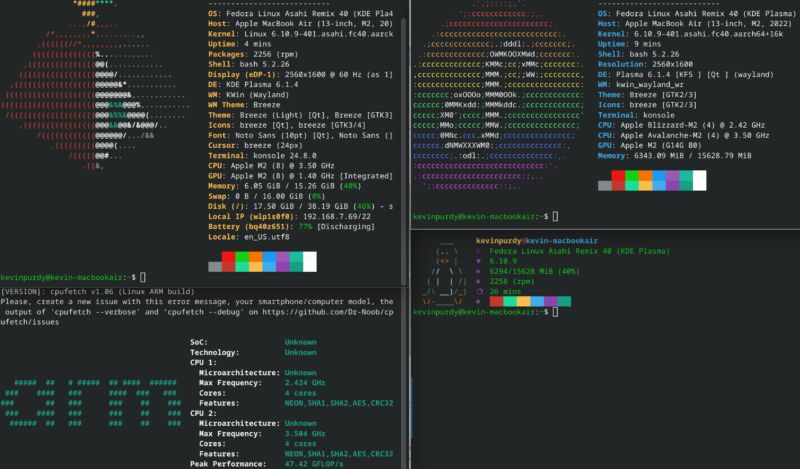
Kevin Purdy
Virtually no person really wanted Neofetch, however the individuals who did use it? They actually favored it.
Neofetch, run from a terminal, displayed key system info alongside an ASCII-art picture of the working system or distribution working on that system. You knew most of this knowledge, however should you’re taking a screenshot of your system, it seemed cool and conveyed a variety of knowledge in a small area. “The general objective of Neofetch is for use in screen-shots of your system,” wrote Neofetch’s creator, Dylan Araps, on its Github repository. “Neofetch exhibits the knowledge different individuals need to see.”
Neofetch did that, offering cool screenshots and proof-of-life photographs throughout practically 150 OS variations till late April. The final replace to the instrument was made three years earlier than that, and Araps’ Github profile now accommodates a moderately succinct coda: “Have taken up farming.” Araps joins “going to a commune in Vermont” and “I now make furnishings out of wooden” within the pantheon of programmers who don’t simply go away the sector, however flee into one other realm fully.
As typically occurs, the void was crammed not by one first rate substitute however many.
-
Fastfetch, which is certainly fairly quick and appears to have extra distros acknowledged (like Asahi Linux on an ARM MacBook).
Kevin Purdy -
Hyfetch, which provides you a bunch of satisfaction flag choices on first working however will also be used with out satisfaction colours.
-
Nerdfetch, which I may by no means fairly get to run completely with Nerdfonts, Cozette, or Phosphor. It is small, which might be helpful, but it surely principally simply exhibits a Tux penguin, not an OS-specific ASCII picture.
-
Cpufetch, which, because the identify implies, drops rather more chip knowledge into the time period.
The neo-Neofetches
Fastfetch appears to have captured the default discussion board/thread/weblog suggestion as a Neofetch substitute. It’s underneath energetic improvement, with modifications occurring simply hours earlier than this publish was revealed. It is extremely customizable, obtainable throughout most main platforms and distributions, and extensible by means of modules. It helps Wayland, supplies extra detailed reminiscence and storage statistics, and, because the identify suggests, is mostly sooner. It is FOSS and has a tutorial on customizing and increasing Fastfetch.
NerdFetch provides you the form of icon customization you may count on should you’re the kind who takes meticulously organized screenshots of your desktop. By putting in one of many glyph-packed Nerd Fonts, you possibly can change textual content inside your readout with icons readable at a look. It is obtainable on POSIX-compliant programs (“Something however Home windows”). It lacks a variety of customization and module choices, and it is lacking the large, customized OS emblem (it seemingly exhibits a really summary ASCII Tux in each MacOS and Asahi Linux). However it’s additionally compact and a bit totally different.
What else? There’s hyfetch, which is “neofetch with satisfaction flags,” but it surely additionally accommodates inside it “neowofetch,” which is an up to date neofetch sans satisfaction coloring. The macchina system data instrument is written in Rust and presents themeing, being “primary by default and extensible by design.” And cpufetch is, as you may think, much more CPU knowledge, together with a emblem. Curiously, cpufetch confirmed an “arm” rendering after I ran it underneath Asahi Linux on a MacBook, however then an Apple emblem whereas inside MacOS. Works both method! Simply attention-grabbing.
Should you’ve put time into getting a Linux desktop simply the way you prefer it—or simply getting Linux onto a tool that basically does not need it—it follows that you simply’d need to present it off. These should not the final of the apps that may attempt to make fetch occur, however they are a sturdy begin.
Itemizing picture by Kevin Purdy
